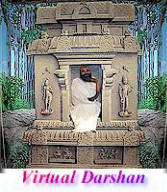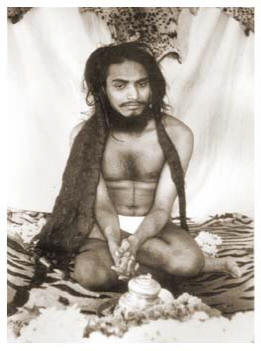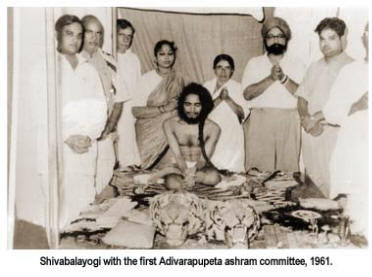|
|
|
Swamiji gave public darshan on Friday nights when hundreds of people gathered at Adivarapupeta. Each Friday afternoon, the devotees prepared a meal of rice and vegetables and perhaps some dal, cooking the food over a fire pit in huge pots that could hold fifty or more gallons of food. The cooking vessels were borrowed, rented, then donated. People would donate the rice, vegetables and other items to be cooked. Most of the work was done by the villagers. They all knew how important the mass feeding was to Shri Swamiji. In Indian tradition, the gift of food (annadanam) is considered one of the most noble spiritual works. Shri Swamiji insisted that all who came to him be given food, a full meal to fill and satisfy the belly. Each Friday night, and into the early hours of the morning, devotees sang bhajans, songs of devotion. Depending on the devotion of the bhajan players, the songs may be to any god, whether Lord Shiva, Rama, Krishna, or the Divine Mother. The typical instruments are the harmonium, a keyboard instrument with bellows and metal reeds that make an organ-like sound, and drums, usually a dholak with a drum head on each end, and finger cymbals. In the South, the style is call-and-response where a leader sings a line and the rest repeat it as a chorus. The beats are varied and syncopated, and the energy builds as the tempo increasingly speeds up. Even during Shivabalayogi’s tapas, particularly during the last four years, people gathered on occasion and sang bhajans outside the meditation temple. Regularly singing bhajans in honor of Shivabalayogi began only after he completed tapas, and it was after tapas that Shri Swamiji generally began giving trance, bhava and bhava samadhi. Shri Swamiji was giving powerful spiritual trances to many people, perhaps scores at a time. This news about strange goings on in Adivarapupeta and the mass feedings quickly passed around the nearby villages and small towns. Soon several hundreds of people began to gather each week. Many people were attracted to get the food served at the mass feedings. Some also came to see the miracles and strange trances during the bhajans. Devotees came for Shivabalayogi’s darshan and to experience the heightened energies during the bhajans and bhava. The powerful young yogi was radiating such powerful spiritual energies that one could not resist the devotion and bhava through the music. Some came with the hope that the young yogi would cure their diseases or for some other miraculous intervention in their lives. Through the people in bhava, many were healed of all sorts of afflictions.
|
 |
|
His Life |
| birth |
| childhood |
| childhood stories |
| enlightenment |
| beginning tapas |
| early obstacles |
| four directions |
| tapas completion |
| Adivarapupeta |
|
Ardhanarishwara Linga & Devi |
| India travels |
|
Banagalore ashram temple |
| Adivarapupeta ashram |
| in the West |
| mahasamadhi |
|
|
| yogi |
| religions |
| spiritual leaders |
| Jesus & Buddha |
| God |
| forms of God |
| guru-devotee |
| Swamiji's mission |
| initiation, vibhuti |
| meditation |
| samadhi (enlightenment) |
| tapas & Self realization |
| bhajans(devotional song) |
|
bhava samadhi (spiritual trance) |
| world conditions |
| foundation |
| Swamiji's words |
| Virtual Darshan |
|
|
|
Shri Shivabalayogi Maharaj
International Trust P.O. Box 293 Langley, WA 98260 U.S.A. info@Shiva.Org |
 After
Shivabalayogi completed tapas, he continued to reside in the small
meditation temple just outside Adivarapupeta village. There he would give
darshan to the occasional devotee or visitor. Most of the time he spent in
samadhi. He remained absorbed in stillness with little apparent interest in
ordinary surroundings. The energy that radiated through the yogi’s body was
so intense that he rarely opened his eyes. Swamiji told people that if he
did open his eyes, even partially, they would not be able to bear it. Only
with very few devotees would Swamiji open his eyes and talk.
After
Shivabalayogi completed tapas, he continued to reside in the small
meditation temple just outside Adivarapupeta village. There he would give
darshan to the occasional devotee or visitor. Most of the time he spent in
samadhi. He remained absorbed in stillness with little apparent interest in
ordinary surroundings. The energy that radiated through the yogi’s body was
so intense that he rarely opened his eyes. Swamiji told people that if he
did open his eyes, even partially, they would not be able to bear it. Only
with very few devotees would Swamiji open his eyes and talk. In
this way, large numbers gathered for different reasons. People came from
nearby towns and a host of villages near Adivarapupeta. Most walked or took
one of the ubiquitous and worn-out busses common throughout India, but a few
came in cars packed with six or eight or more adults and children. There
were always a few attracted from outside the area. Perhaps they heard about
Balayogi of Adivarapupeta in Madras or Mysore State, or perhaps they were
visiting a nearby temple or holy person and heard stories about the unusual
goings on in Adivarapupeta. Shri Swamiji served them all.
In
this way, large numbers gathered for different reasons. People came from
nearby towns and a host of villages near Adivarapupeta. Most walked or took
one of the ubiquitous and worn-out busses common throughout India, but a few
came in cars packed with six or eight or more adults and children. There
were always a few attracted from outside the area. Perhaps they heard about
Balayogi of Adivarapupeta in Madras or Mysore State, or perhaps they were
visiting a nearby temple or holy person and heard stories about the unusual
goings on in Adivarapupeta. Shri Swamiji served them all.